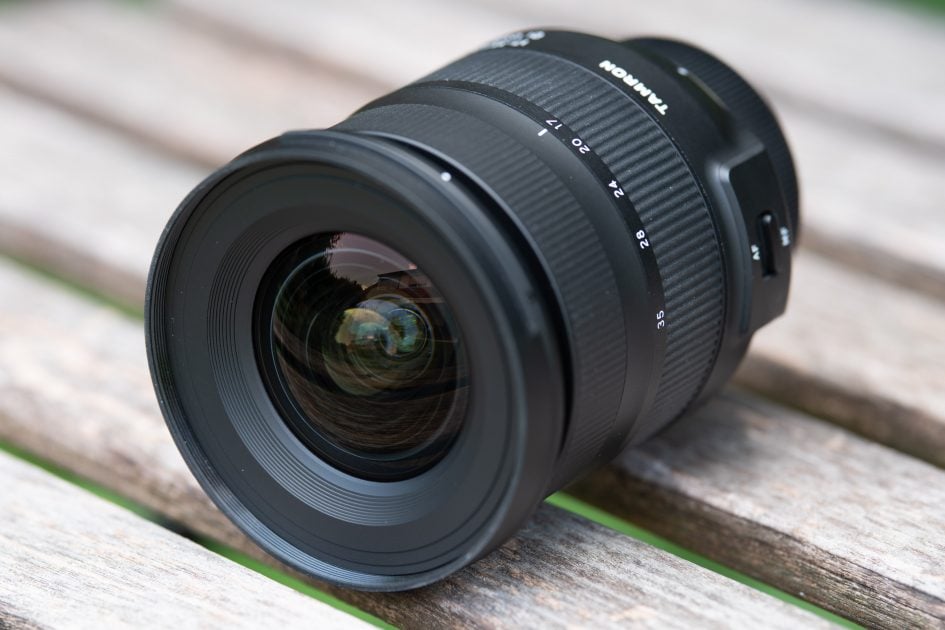Tamron 17-35mm f2.8-4 review
-
-
Written by Thomas
In depth
The Tamron 17-35mm f2.8-4 Di OSD is a relatively small and light non-stabilized wide-angle zoom lens with a large f2.8 focal ratio at the short-end that’s designed for full-frame cameras and available in Canon and Nikon mounts.
Announced in August 2018 it joins Tamron’s stabilized 15-30mm f2.8 VC lens from 2015 and goes directly up against other wide angle zooms, most notably Nikon’s AF-S 18-35mm f3.5-4.5G ED and the Tokina AT-X 17-35mm f4 FX. As you would expect from any new Tamron lens it is compatible with their USB TAP-in console to fine tune various characteristics of the AF. The lens is not a member of Tamron’s high-end “SP” line but still has a list price of 999 EUR.
To find out how the new Tamron 17-35mm f2.8-4 performs I tested it against Tamron’s own 15-30mm f2.8 VC, Nikon’s 18-35mm f3.5-4.5 and Tokina’s AT-X 17-35mm f4.0 FX on the demanding D850 body. So if you’re shopping for a full-frame wide angle zoom, you’ve come to the right place!
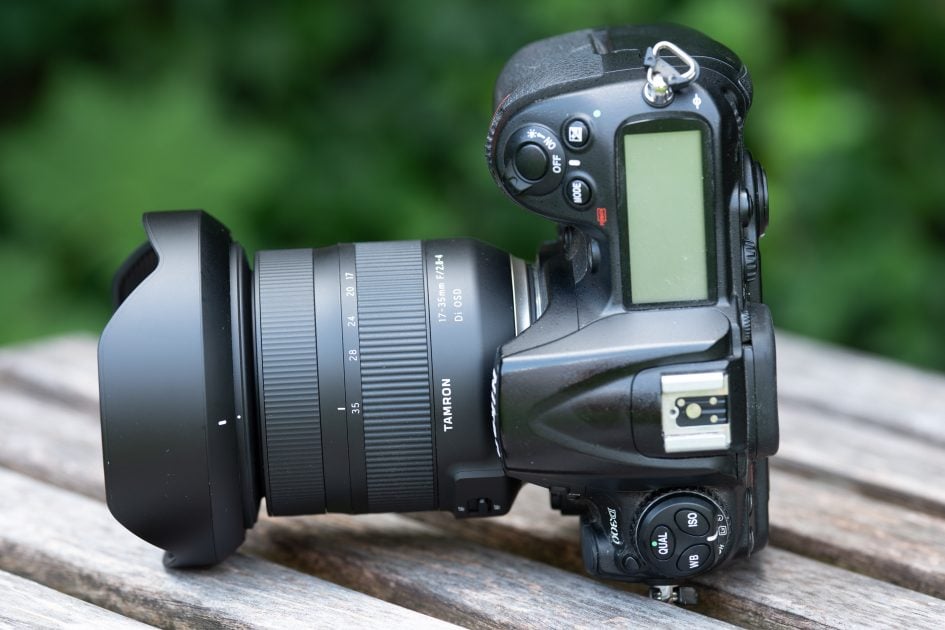
Facts from the catalog
As usual I’ll have a look at the technical data of the new Tamron 17-35mm first. I’ve rated the features with a [+] (or [++]), when it’s better than average or even state of the art, a [0] if it’s standard or just average, and [-] if there’s a disadvantage. For comparison I use the Tamron 15-30mm f2.8 VC (“Tamron 15-30mm” for short), the Nikon 18-35mm f3.5-4.5 (“Nikon”) and Tokina’s 17-35mm f4.0 (“Tokina”).
Size (diameter x length): 84 x 90mm (3.3 x 3.5in.) plus 29mm for the lens hood which is 101mm in diameter. Zooming out to 17mm adds 6mm to the total length of the lens. The Tamron 15-30mm is 98 x 143mm. which is very bulky in comparison. The Nikon is 83 x 95mm plus 31mm for the lens hood, the Tokina 89 x 94mm plus 33mm for the lens hood. [0]
Weight: 460g (16.2 oz.) plus 31g for the lens hood. The Tamron 15-30mm is 1052g. The Nikon weighs 385g + 19g for the lens hood, the Tokina 591g + 26g for the lens hood. So the new Tamron 17-35mm is not the lightest of the bunch but as it offers a larger focal ratio than the Nikon that’s OK. At least it is much lighter than its larger sibling, the Tamron 15-30mm. [+]
Optics: 15 elements (including 4 special dispersion and 2 aspherical elements) in 10 groups vs. 18/13 for the Tamron 15-30mm, 12/8 for the Nikon and 13/12 for the Tokina. The new Tamron 17-35mm is the only lens in this group that employs fluorine coating on the front of its new lens to repel water, dust, and dirt and should make for easier cleaning. Only the newly announced 2nd generation Tamron 15-30mm has a fluorine coating too. [+]
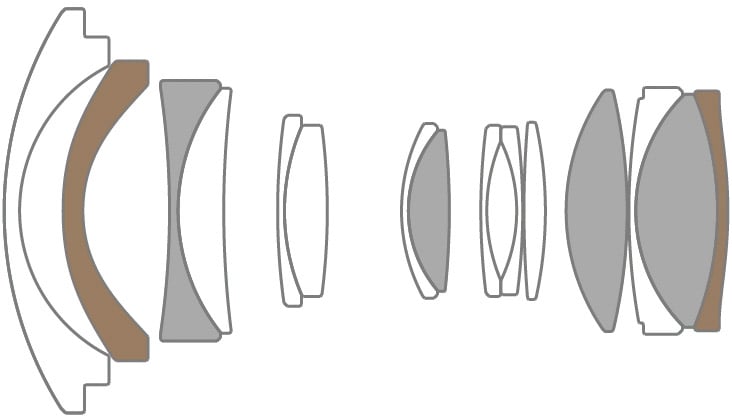
Closest focus distance is 0.28m (11in.) with a magnification of 1:4.9 at 35mm focal length. In my test I was able to get down to 1:3.9 at 0.25m with manual focus. The magnification of the new Tamron 17-35mm is quite good but you have only 11cm (4.3in.) of working distance at minimum focus distance. A magnification of 1:10 is achieved at 0.47m giving a working distance of 0.30m with lens hood attached. The other lenses achieve slightly smaller magnifications of around 1:4.5 with similar working distances and minimum focus distances. [0]
Filter-thread: 77mm which is the de facto standard and shared with the Nikon. The Tokina uses 82mm filters. And the Tamron 15-30mm does not offer a filter-thread on its bulbous front element. [+]
Image stabilization: No. The only wide angle zooms that offer optical image stabilization are the Tamron 15-30mm f2.8 VC, the Nikon 16-35mm f4.0G ED VR, and the Canon EF 16-35mm 4.0 L IS USM. [0]
Auto focus: OSD (Optimized Silent Drive), so it also works on camera bodies which don’t have an AF-drive built in like Nikon’s D3x00/5×00. Manual-focus override is by simply turning the focus ring. Same with the competition except for the Tokina where you need to pull the focus ring back to engage manual focus. The new Tamron 17-35mm allows you to alter focus fine-tuning at 5 focal lengths and 3 distances with the USB TAP-in console. It’s the only lens in this group currently offering this feature. But the newly announced Tamron 15-30mm G2 (second generation) is also compatible with Tamron’s USB console. [+]
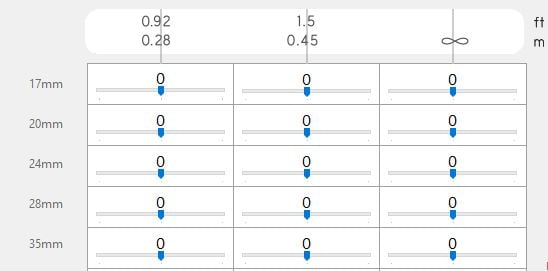
Covers full frame/FX or smaller = very good. Same with the competition. [+]
Price: The street price already dropped from the lofty list price of 999 EUR to 730 EUR (incl. 19% VAT) / 599 USD. The Tamron 15-30mm goes for 950 EUR / 1100 USD. The Nikon sells for 700 EUR / 570 USD, the Tokina for 500 EUR / 400 USD. [0]
Comes with no lens-case but the lens hood is included, reversible for transport, and the lens-caps are standard. That’s similar to the other lenses. Only the Tamron 15-30mm has a built-in petal hood and only the Nikon includes a soft lens pouch. [0]
Distance information is relayed to the camera, so the camera and flashes can do all the advanced exposure-related stuff with this lens. Same for the competition. The Canon version of the lens is currently not compatible with the lens aberration corrections available in recent Canon bodies to compensate for vignetting, chromatic aberrations and distortion. It is recommended to switch these corrections off. Tamron hopes to have a firmware update at a later date. [+]
Aperture ring: no, same as with the competition. The aperture is actuated electromagnetically in the Nikon-version too which makes it the equivalent of a modern E-type Nikon lens and puts away with the mechanical coupling that Nikon uses on all older lenses like the Nikon 18-35mm f3.5-4.5G. The Tamron 15-30mm and the Tokina also use mechanical coupling in their Nikon mount version. [0]
Sealing: yes, a rubber grommet at the lens-mount plus further special weather-sealing throughout the construction. [+]
The score in the “features-department” is 0[-]/6[0]/7[+]. So the lens has a well-balanced feature set. On the plus side is it’s large 1:2.8 focal ratio at the short end, its fluorine coating, and the compatibility with the TAP-in console.
Four wide angle zoom lenses
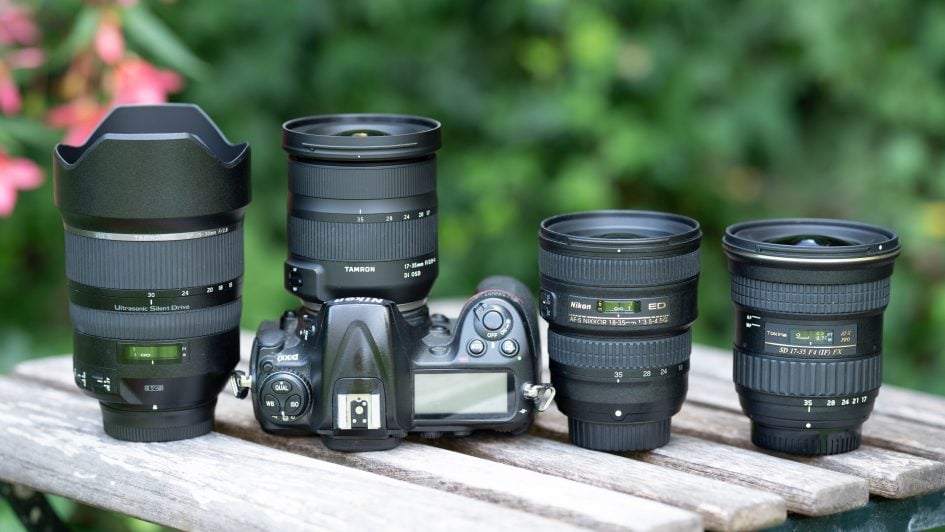
Above from left to right: Tamron 15-30mm f2.8 VC, Tamron 17-35mm f2.8-4, Nikon 18-35mm f3.5-4.5G, Tokina 17-35mm f4.0
Alternatives
The market for full-frame wide-angle zooms reaching 35mm focal length is pretty crowded: every manufacturer offers at least two lenses with the notable exception of Sigma:
- Nikon has the 18-35mm f3.5-4.5G ED from 2013 for 700 EUR / 570 USD. For more information see my Nikon 18-35mm f3.5-4.5 review where it got a Recommended. Then there’s the stabilized 16-35mm f4.0G ED VR from 2010 for 1150 EUR / 1100 USD which came Recommended in my Nikon 16-35mm f4.0 VR review. And finally the 17-35mm f2.8D IF-ED, which is an older design from 2003 but offers a constant f2.8 focal ratio and is pretty expensive (1700 EUR / 1950 USD).
- Astonishingly Sigma has no directly comparable lens on offer. It does have the Sigma Art AF 18-35mm f1.8 DC HSM IF with a bright constant aperture of f1.8 but this lens covers only APS-C / DX sensors (720 EUR / 800 USD).
- Canon has the stabilized EF 16-35mm 4.0 L IS USM from 2014 (980 EUR) and the EF 16-35mm 2.8 L III USM from 2016 with a street price around 1950 EUR.
- Tamron offers the stabilized 15-30mm f2.8 Di VC USD for about 1100 USD / 950 EUR. Its widest angle of view is 110 degrees but it lacks 5mm on the long end of its zoom range. With its constant f2.8 focal ratio and image stabilization it’s the largest and heaviest lens in this group but earned a Highly Recommended in my Tamron 15-30mm f2.8 VC review. The newly announced second generation of this lens has improved coating, image stabilization, and focus drive but optically is the same design. So all results shown here from the first generation lens regarding sharpness, resolution, coma, and Bokeh should be valid for the 2nd generation lens too.
- Tokina has the AT-X 17-35mm f4.0 FX from 2011 (500 EUR / 400 USD) and the AT-X Pro 16-28mm 2.8 FX from 2010 (600 EUR / 580 USD).
- Sony has two offerings covering 16-35mm focal range for full frame e-mount bodies: the FE 16-35mm f4.0 ZA OSS (1200 EUR) and the FE 16-35mm f2.8 GM (2400 EUR). Gordon’s tried the latter and put together some sample images in his Sony FE 16-35mm review so far. As the new Tamron is not available for e-mount the two Sony lenses are the only choices for Sony owners unless they use a Canon EF to Sony E mount converter.
Here is the angle of view that the new Tamron 17-35mm covers with its 2.1x zoom:

Above: Tamron 17-35mm f2.8-4 coverage on Nikon D850 (FF/FX) body at 17mm (left) and 35mm (right)
Following is the coverage of the Tamron 15-30mm zoom:

Above: Tamron 15-30mm f2.8 VC coverage on Nikon D850 (FF/FX) body at 15mm (left), at 30mm (right)
Focus and zoom
Focus accuracy and repeatability is critical to consistently produce sharp shots. Repeatability (the accuracy of focus on the same subject after repeated focus-acquisition in phase detect mode) of this lens at standard settings and 35mm focal length is very good (measured 99.4% in Reikan FoCal) with no outliers over a series of 40 shots. There is no focus variation whether the lens focuses from a closer distance or from infinity. At 35mm focal length the lens focuses without hunting in around 0.6 sec from infinity to 0.47m (1:10 magnification), which is fast enough in my book. The Tamron 15-30mm needs only 0.3 sec while the Nikon is the slowest of the bunch at 0.7 sec. Both lenses produce focus accuracy and repeatability very similar to the new Tamron. The Tokina shows the biggest inconsistencies in focusing measured only 89.7% in FoCal with one severe outlier and needs 0.5 sec.
The focus ring of the new Tamron has no slack/play between its movement and the focus-action and a throw of 55 degrees which is barely enough for exact manual focus. It turns the way Canon users are used to but does not offer a window with a distance scale. Its rubberized surface is 15mm wide and it offers quite some resistance as long as it’s coupled to the internal AF motor of the lens. When you switch the lens to manual focus the focus ring moves extremely easy. The focus ring has hard limits at minimum focus distance and a bit beyond infinity, and it turns with the AF action. This disturbed me quite a bit because when I hold a lens my fingers normally touch the foremost ring.
The zoom ring turns through 60 degrees the way Nikon users are used to and has a 19mm wide rubber surface. The zoom ring turns turns pretty smooth and can be operated with one finger. The focus ring is at the front and the zoom ring closer to the camera but not too close for it to interfere with the protruding nose where some camera bodies have their built-in flash. Personally I prefer having the zoom ring at the front which only the Tamron 15-30mm offers.
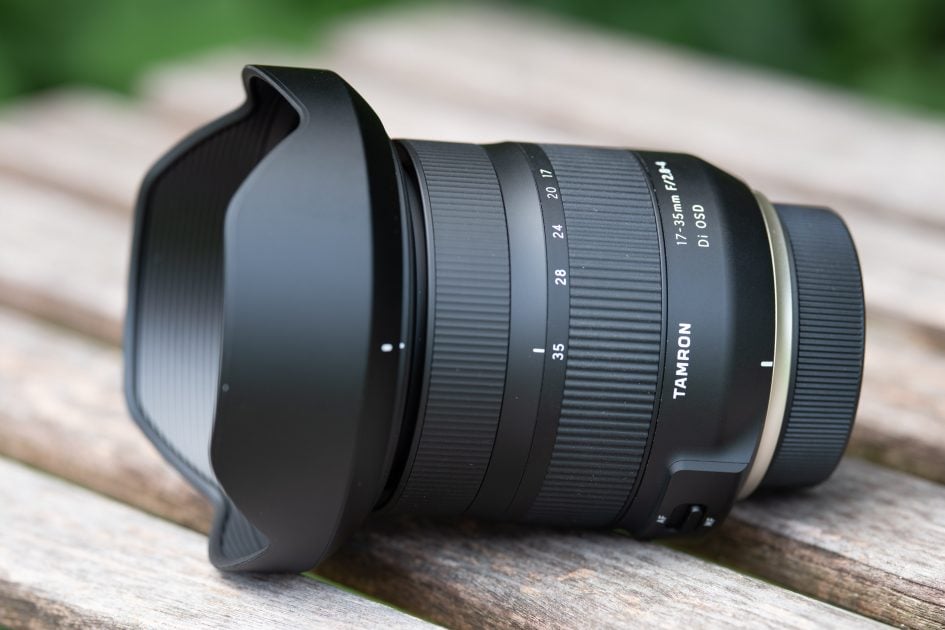
AF-operation is audible from the outside but if you record video with the built-in microphone the AF-drive produces no hard tocks/clicks at the start or stop of focus-movements and movement was not too noisy. The Tokina is a bit noisier, the Tamron 15-30mm moves almost silently but produces annoying clicks at the start and stop of a focus movement, and the Nikon is the quietest overall.
As you pull focus, you’ll notice some focus breathing: the image becomes less magnified at closer focusing distances. When I adjusted the focus from infinity to 0.47m on the Tamron at 35mm focal length, I measured a 2% decrease in magnification. The Tamron 15-30mm, Nikon and Tokina all show a similar decrease. So these lenses should not produce disturbing focus breathing when recording video. Very good!
Next check out my quality results!
Check prices on the Tamron 17-35mm f2.8-f4 at Amazon, B&H, Adorama, or Wex. Alternatively get yourself a copy of my In Camera book or treat me to a coffee! Thanks!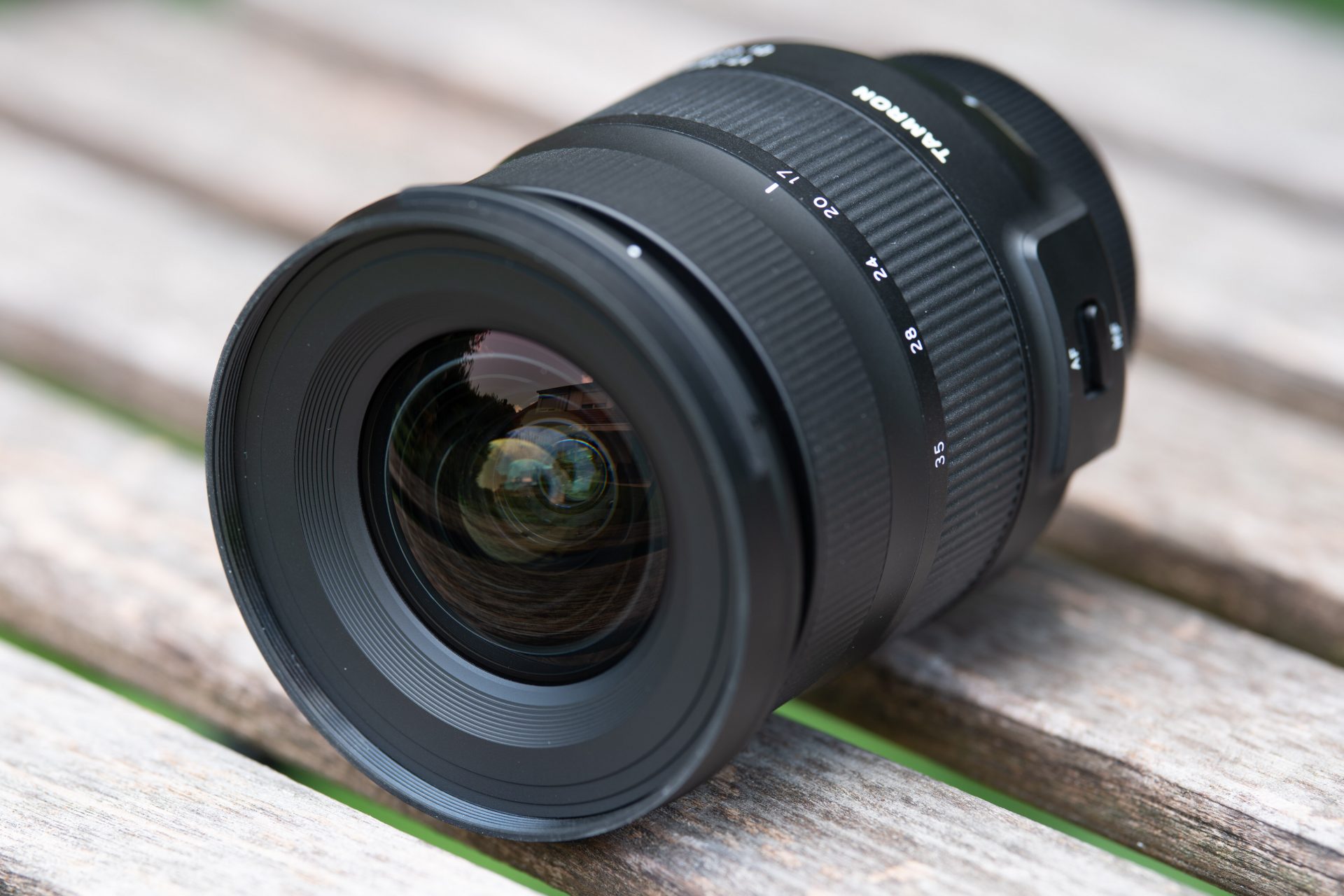
 The Tamron 17-35mm f2.8-4 is a very compelling small and light wide-angle zoom lens. It is very sharp in the center throughout the zoom-range. The APS-C/DX-corner is sharpest at 21mm and softens a bit towards the long-end, while the FF/FX-corner is sharpest at the long end and softens up a bit below 24mm focal length. It performs well in contra-light and focuses reliably plus it has extensive weather sealing. So the Tamron 17-35mm f2.8-4 deservedly earns a Recommended rating.
The Tamron 17-35mm f2.8-4 is a very compelling small and light wide-angle zoom lens. It is very sharp in the center throughout the zoom-range. The APS-C/DX-corner is sharpest at 21mm and softens a bit towards the long-end, while the FF/FX-corner is sharpest at the long end and softens up a bit below 24mm focal length. It performs well in contra-light and focuses reliably plus it has extensive weather sealing. So the Tamron 17-35mm f2.8-4 deservedly earns a Recommended rating.



